Final Draft
Note Designs for Complete Streets at End of Policy
Town of Stratford, Connecticut
Complete Streets Policy
Summary: The Town of Stratford has made significant progress toward a local complete streets program. Early efforts of the town’s Greenway Committee lead to the development of a comprehensive complete streets plan for areas including and connecting to the town center and transit-oriented district. To effectively advance these projects toward completion, this report recommends the adoption of a local complete streets policy to integrate future road design and funding decisions in a manner that promotes sustainable accommodation of all roadway users.
Purpose: The purpose of the Town of Stratford’s Complete Streets Policy is to accommodate a wide range of road users by creating a road network that meets the needs of individuals utilizing a variety of transportation modes. The policy will be applied as a guide in decision-making in related infrastructure planning and construction, and create a framework for future development that beautifies the public realm; transforms streets into active, healthy corridors for all modes of travel; connects residents and visitors to major destinations; provides a safe, accessible environment for users of all ages and abilities; and, revitalizes Stratford Center. By incorporating Complete Streets as a guide, the Town of Stratford will advance its efforts to provide safety and accessibility for all the users of our roadways, trails and transit systems, including pedestrians, bicyclists, transit riders, motorists, commercial vehicles, and emergency vehicles for people of all ages and of all abilities.
In addition, the recent Complete Streets Improvement Plan developed for Stratford Center recommends adoption of a complete streets policy to guide local investment decisions, as those in effect by many towns throughout the country. As such, the town’s Greenway Committee and Planning & Zoning Commission conducted a survey of best complete streets practices across the country and recommend council adoption of the following policy to support integration of complete streets in roadway design projects, and focused implementation of priority projects included in the town’s Complete Streets and Housatonic Greenway Plan (Appendix A):
Complete Streets Policy
The Town of Stratford aims to improve the health of its residents and acknowledges that Complete Streets can increase everyday physical activity by enabling additional walking and bicycling by its residents and visitors. It is the intent of the Town of Stratford to formalize the plan, design, operation and maintenance of streets so that they are safe for all users of all ages and abilities as a matter of routine. This policy as adopted by the Town Council with support of its legislative Commissions, guides decision makers in consistently planning, designing, and constructing streets to reasonably accommodate all anticipated users including, but not limited to pedestrians, bicyclists, motorists, emergency vehicles, and freight and commercial vehicles. It further serves as a guide for town development and Public Works/Engineering department officials to ensure the integration of complete streets principles in the planning, design, and construction of local infrastructure.
Core Commitment & Objectives: The Town of Stratford recognizes that roadway projects, whether new, maintenance, or reconstruction, are potential opportunities to apply Complete
Streets design principles and support the towns goals for Transit-Oriented Development. The Town will, to the maximum extent practical, design, construct, maintain, and operate streets to provide for a comprehensive and integrated street network of facilities to achieve the following objectives:
- Increase safety and access for all ages, abilities, and modes
- Create better connections between residential and commercial areas
- Ensure Stratford Center will support future development and growth
- Improve access to and between public transit systems (e.g., rail and bus)
- Develop safe routes to school for students
- Explore design interventions that create a sense of place, reflect the character of Stratford’s different neighborhoods, and evoke a sense of safety and vibrancy
- Soften existing barriers (e.g., I-95 and rail corridor)
- Embrace Stratford’s cultural arts, history, and natural resources
- Integrate traffic calming measures to slow traffic and encourage active transportation in key areas
- Incorporate green infrastructure, and support of the town’s MS4 program for stormwater
Design Practices: To ensure that Complete Streets projects accommodate all modes of travel and all users, while still providing flexibility to allow designers to tailor the project to unique circumstances, the planning and design shall adhere to the guidelines and principles included in the AASHTO Guide for the Development of Bicycle Facilities and Guide for Planning, Design and Operation of Pedestrian Facilities, the Americans with Disabilities Act Accessibility Guidelines, in consult with other available best practices (Appendix B), and shall consider the following elements:
- Bicycle facilities, including designating bicycle routes, installing bicycle lanes, installing “Share the Road” signs, providing bicycle racks and adding appropriate pavement markings, such as sharrows, bike lane symbols and shoulder edge lines;
- Bus features and amenities, including constructing bus pull-outs, installing shelters with ample room for boarding and alighting, ensuring bus stops and shelters are well connected to the pedestrian network and there is a clear path to and from the bus stop, and coordinating with transit officials so that their operating needs are adequately considered and incorporated into the design;
- Pedestrian enhancements, including installing crosswalks, upgrading pedestrian signal equipment and timing such as countdown clocks and providing a Leading Pedestrian Interval (LPI), constructing curb ramps that meet ADA standards, and providing sidewalks that are well maintained, meet width needs and are interconnected;
- Traffic calming actions, including using textured material at crosswalks, bumping-out intersection curbs to shorten the walk distance, installing center refuge islands, and installing raised intersection tables;
- Streetscape environment, including planting urban appropriate trees, landscaping, installing bio-swales and rain gardens, using permeable paving material, such as concrete pavers and porous asphalt, and providing a buffer between the street and sidewalk; ADA compliant features, including curb ramps, detectable tactile cues and warnings, accessible pedestrian signals that emit audible sounds, have a locator tone at the pushbutton or use vibrotactile devices, and increasing the walk time to accommodate persons with disabilities;
- Encourage off-street parking, consider eliminating on-street parking where appropriate, and on-street parking treatments, including designated spaces delineated by a unique pavement treatment (textured material, concrete pavers) and curb/sidewalk bump-outs; and
- Access management actions to manage and control ingress/egress at commercial driveways, including consolidations, reduction in the number, closures, modifying allowed movements, and incorporating good sidewalk design across driveways.
Implementation: Complete Streets implementation should be constantly evaluated for success and opportunities for improvement. The Town will adopt performance measures to gauge implementation and effectiveness of the following policies.
- The Town shall make Complete Streets practices a routine part of everyday operations, shall approach every transportation project and program as an opportunity to improve streets and the transportation network for all users, and shall work in coordination with other departments, agencies, and jurisdictions to achieve Complete Streets.
- Town shall review and either revise or develop proposed revisions to all appropriate planning documents (master plans, open space and recreation plan, etc.), zoning and subdivision codes, laws, procedures, rules, regulations, guidelines, programs, and templates to integrate Complete Streets principles in all Street Projects on streets, as well as potential off-road trails and paths.
- The Town shall maintain a comprehensive inventory of pedestrian and bicycle facility infrastructure that will prioritize projects to eliminate gaps in the sidewalk and bikeway The Public Works Department, Town Engineer, Town Planner and any other relevant town department, in consultation with METRCOG and the State Department of Transportation, will monitor and maintain a GIS layer of Complete Streets data and report on performance metrics as follows:
- Inventory
- Linear feet of new or reconstructed sidewalks
- Miles of new or restriped on-street bicycle facilities
- Number of new or reconstructed curb ramps
- Number of new or repainted crosswalks
- Number of new street trees/percentage of streets with tree canopy
- Percentage completion of bicycle and pedestrian networks as envisioned by city plans
- Percentage of transit stops with shelters
- Percentage of transit stops accessible via sidewalks and curb ramps
- Monitoring
- Efficiency of transit vehicles on routes
- Multimodal Level of Service (MMLOS)
- AutoTrips Generated (ATG)
- Decrease in rate of crashes, injuries, and fatalities by mode
- Transportation mode shift: more people walking, bicycling, and taking transit
- Rate of children walking or bicycling to school
- Vehicle Miles Traveled (VMT) or Single Occupancy Vehicle (SOV) trip reduction
- The Town will reevaluate prioritization of Capital Improvement Projects to encourage the connectivity of Complete Streets with a focus on implementation of project schedules and maps included in the Stratford Center Complete Streets Improvement Plan and the Housatonic Greenway Plan (Appendix A).
- The Town will make its best effort, as resources allow, to train pertinent town staff and decision-makers on the content of Complete Streets principles and best practices for implementing policy through workshops and other appropriate means.
- The Town will utilize inter-department coordination to promote the most responsible and efficient use of resources for activities within the public way and will make a best faith effort to coordinate with adjacent municipalities to ensure a seamless network of facilities for all users of the roadway.
- The Town will seek out appropriate sources of funding and grants for implementation of Complete Streets policies. This includes transportation infrastructure and street design projects requiring funding or approval by the Town of Stratford, as well as projects funded by the state and federal government, Transportation Improvement Program (TIP), Community Development Block Grants (CDBG), Capital Funding and other state and federal funds for street and infrastructure design.
- The Town will work with local developers to incorporate complete streets design principles as appropriate in private development projects. Imposition of such requirements should be made on projects that will significantly advance the town’s comprehensive complete streets objectives, as determined by the Town Engineer.
- The Town Engineer, in consultation with the Department of Public Works and local Task Force as needed, will use best judgment regarding the feasibility of applying complete streets principles for routine roadway maintenance and projects. The same will be applied to private developments and related street design components or corresponding street- related components. Other transportation infrastructure projects, including but not limited
to roadway reconstruction, roadway reconfigurations, or subdivisions, transportation infrastructure may be excluded, upon approval by the Mayor and/or its designee, where documentation and data indicate that:
- Cost or impacts of accommodation is excessively disproportionate to the need or probable use or probable future use.
- Roadways where specific users are prohibited by law. An effort will be made, in these cases for accommodations elsewhere.
- Other Town policies, regulations, or requirements contradict or preclude implementation of complete streets principles.
Recommendations & Impact: Adoption of a Complete Streets policy will have various impacts across town departments. At an executive/ management level, the cost of capital improvement projects can be expected to increase in line with the level of accommodation made on a proposed route. That said, the type of improvements made under a complete streets policy often benefit a larger cross-section of users, and have other benefits aside from simple accommodation of motorized transportation. Reductions of vehicular traffic, enhanced biofiltration, and improved public health have significant economic and environment benefits which can offset the cost of more extensive capital improvements.
Implementation of this policy should focus on the creation of a contiguous local and regional system for non-motorized travel. To ensure investment is first made in the highest impact areas, priority shall be placed on the recommendations included in the Town’s Stratford Center Complete Streets Improvement Plan, and Housatonic Greenway Plan. Concurrent to implementation of these priority projects the town shall pursue the development of a town-wide complete streets plan and concept network map to guide future investment decisions along other local and regional routes not currently identified as priorities in previous town planning initiatives.
Furthermore, the Town Engineering, Public Works Departments and other relevant departments will require additional support for the development, monitoring, and maintenance of Complete Streets improvements, without which comprehensive compliance will not be achieved. These facilities typically require additional design and maintenance, and as result are more expensive from a long term operational perspective. These costs, in addition to the thorough review and reporting requirements included in the proposed policy, suggest consideration should be made to the establishment of a cross-departmental complete streets task force to share the responsibility, workload, and cost of complete street improvements.
Appendix A: Identified Priority & Connectivity Projects
Project Prioritization Criteria:
Community Need & Impact: This category considers existing street conditions, such accessibility, safety concerns, and multimodal infrastructure, and assesses the ability of a given project to significantly improve existing conditions and positively impact the community.
CONNECTIVITY: This category considers how well a proposed project connects residents and visitors to local and regional destinations and the integration of different modes of transportation. SYNERGIES WITH EXISTING EFFORTS: This category assesses the extent to which a proposed project advances the goals of other local and regional projects. For example, projects that achieve goals relevant to complete streets, coastal resilience, and greenway implementation should be prioritized over projects that address only one of these Town initiatives.
BENEFIT/ COST: This category compares the long-term community health, safety, and welfare benefits of a project to capital investment required to construct the project.
Sample Priority Projects:
Main Street (North of E. Broadway to Barnum Avenue)
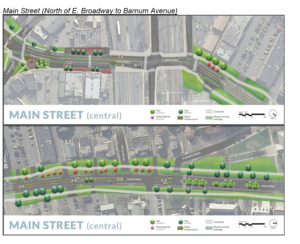
Main Street (North of Barnum Avenue to Fenelon Place)
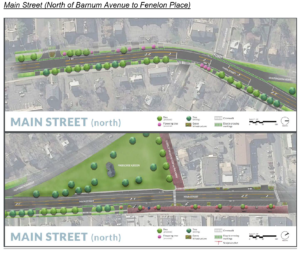
Main Street (South of E Broadway to Stratford Avenue)
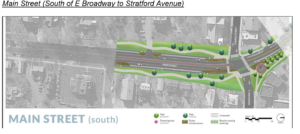
Ferry Boulevard (Main Street East to Exit 33)
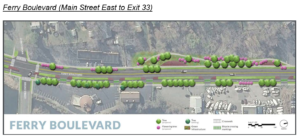
Nichols Avenue (Barnum Avenue North to Lincoln Street)
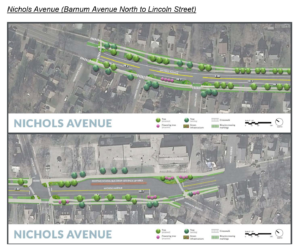
Broad Street (Ferry Boulevard to Linden Street)
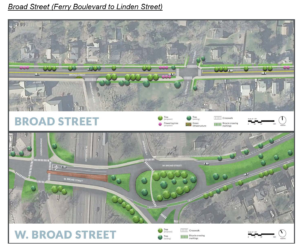
Final plan details available at:
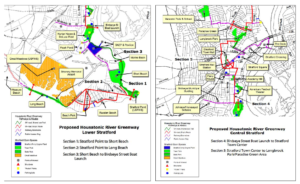
Complete Street Plan for Stratford Center: http://www.townofstratford.com/filestorage/39879/ 73757/StratfordCompleteStreets_DraftPlan_Spread s_HiRes_-_compressed.pdf
Housatonic Greenway Plan: http://www.ctmetro.org/uploads/PDFs/Publications
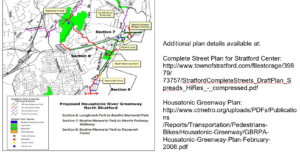
/Reports/Transportation/Pedestrians- Bikes/Housatonic-Greenway/GBRPA-Housatonic- Greenway-Plan-February-2008.pdf
Appendix B: Best Practices as identified by Town Greenway Committee
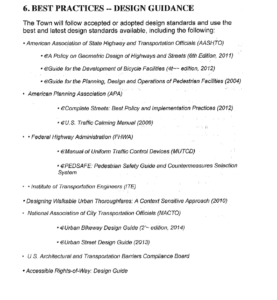




My comment is in regard to where East Broadway meets Ferry Blvd. An apartment complex was built there with a selling point being walkability (part of Complete Streets?) to the town center and the train station, however a stretch of walkway there has for years had poison ivy and other weeds crawling onto and hanging over cracked and unsafe pavement, a derelict building, poor lighting, and currently hosts several abandoned shopping carts. The other side of the street offers no better options for walking. In addition, there should be signage for traffic to stop for pedestrians in the crosswalk leading from the apartments to the other side of Ferry Blvd. I hope some attention will be paid, and corrections made. Thanks for your time.